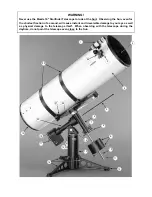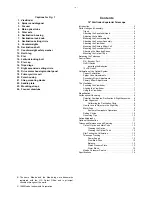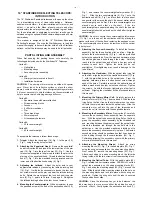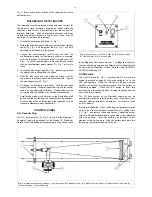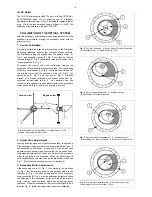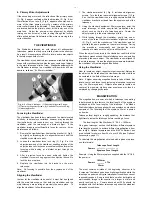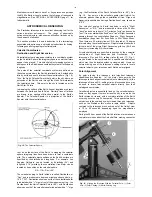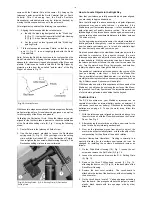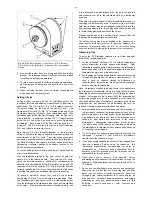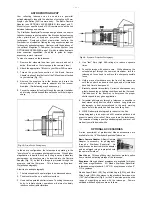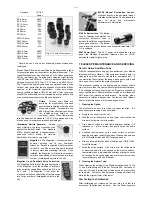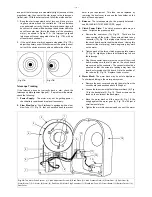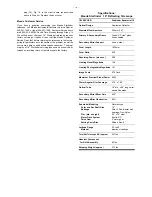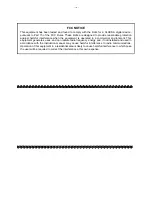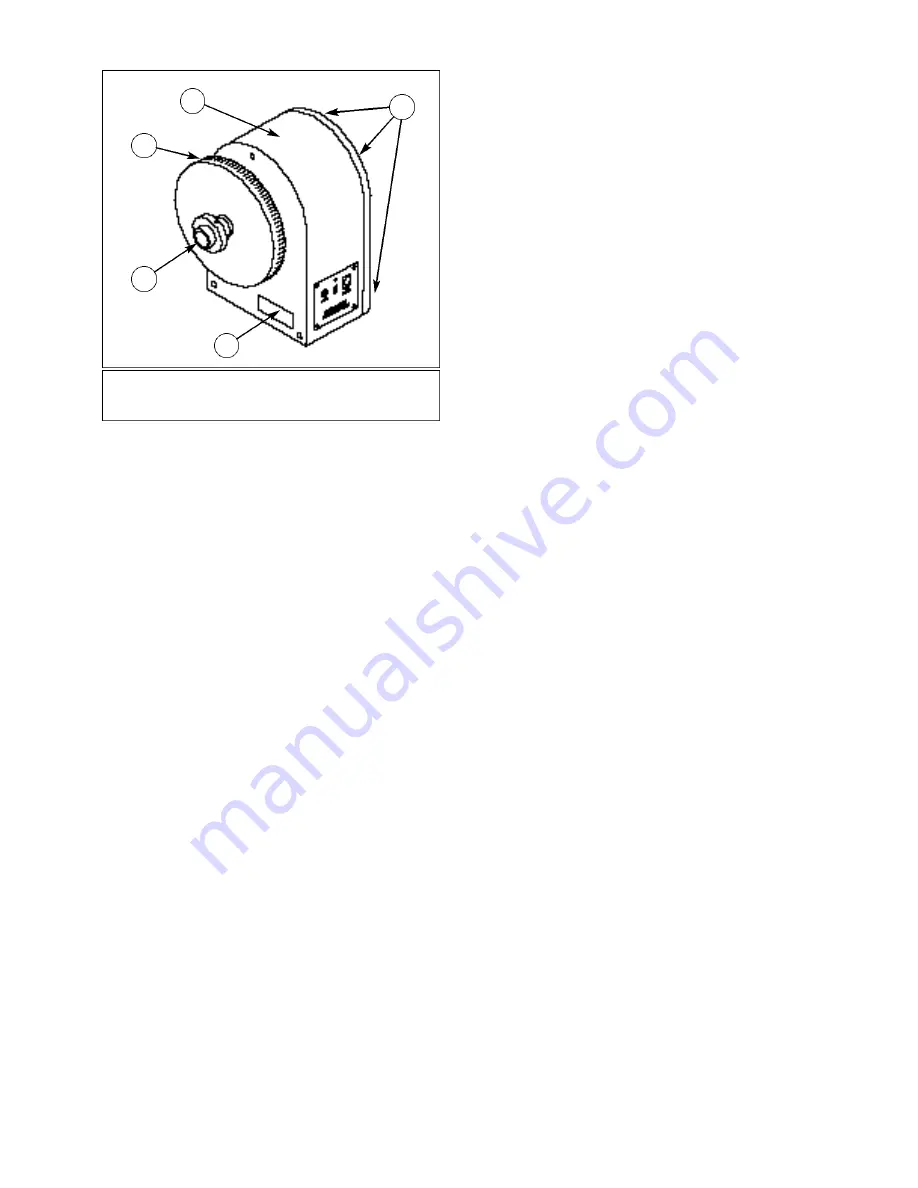
- 10 -
6. Remove the jumper from one prong and slide it onto both
prongs. The telescope will now track in an easterly direction
for southern hemisphere operations.
7. To return the telescope to northern hemisphere operations,
pull the jumper off both prongs and store it on one of the
prongs.
8. When replacing the dust cover, be careful of keeping the
wires away from the gear system.
Setting Circles
Setting circles included with the 16" Starfinder permit the
location of faint celestial objects not easily found by direct visual
observation. The R.A. circle (1), Fig. 13, is located at the end of
the polar housing, on the side of the Control Panel. The
Declination (Dec) circle (2), Fig. 13, is located at the end of the
Declination Housing, just above the counterweight shaft. With
the telescope pointed at the North Celestial Pole, the Dec circle
should read 90° (understood to mean +90°). Objects located
below the 0-0 line of the Dec circle carry minus Declination
coordinates. Each division of the Dec circle represents a 1°
increment. The R.A. circle runs from 0hr to (but not including)
24hr, and reads in increments of 5min.
Note that the R.A. circle is double-indexed; i.e., there are two
series of numbers running in opposite directions around the
circumference of the R.A. circle. The outer series of numbers
(increasing counterclockwise) applies to observers located in
the Earth's Northern Hemisphere; the inner series of numbers
(increasing clockwise) applies to observers located in the
Earth's Southern Hemisphere.
To use the setting circles to locate an object not easily found by
direct visual observation:
With the telescope aligned to the pole, center an object of
known R.A. in the telescopic field. Then turn the R.A. circle,
which can be rotated manually, until the R.A. coordinate of the
object is correctly indicated by the R.A. pointer. As long as the
telescope's motor drive remains "ON," the R.A. pointer will then
correctly indicate the R.A. of any object at which the telescope
is pointed throughout the duration of the observing session.
To locate a particular object, first look up the celestial
coordinates (R.A. and Dec) of the object in a star atlas. Then,
turn the telescope to read the correct R.A. of the desired object.
Turn the telescope in Declination to read the correct Declination
of the object. If the procedure has been followed carefully, and
if the telescope was well-aligned with the pole, the desired
object should now be in the telescopic field of a low-power
eyepiece.
If the object is not immediately visible through the telescope, try
searching the adjacent sky area. Because of its much wider
field, the viewfinder may be of significant assistance in locating
and centering objects, after the setting circles have been used
to locate the approximate position of the object.
Pinpoint application of the setting circles requires that the
telescope be precisely aligned with the pole.
The setting circles may also be utilized in the absence of a
power source for the motor drive. In this case, however, it is
necessary to manually reset the R.A. of the object being
observed just before moving the telescope to the next object.
Observing Tips
To enjoy the 16" Starfinder telescope to its fullest potential,
follow these recommendations:
1. Let the telescope "cool down" to the outside temperature
before attempting to make serious observations. After
removing the telescope from a warm house, the telescope's
optics need about 30 to 45 minutes to adjust to the outside
temperature before they will perform well.
2. Avoid setting up the telescope inside a room and observing
through an open window (or, worse, a closed window!). In
such a case air currents caused by differences in
indoor/outdoor temperatures make quality astronomical
optical performance impossible.
Note: A practical exception to the above rule is the case where
the Starfinder is, for example, set up in a living room or den for
observing an outdoor terrestrial scene or view through a closed
window. At low powers (up to about 60X) the telescope will
perform reasonably well in this application, but the observer
should understand clearly that optical performance under these
conditions can not approach the performance that will be
realized if the telescope were instead set up outside.
3. As discussed above, avoid "overpowering" the telescope. If
the terrestrial or astronomical image becomes fuzzy at high
powers, drop down to a lower power. Image degradation at
high powers is not due to any fault of the telescope but is
caused by heat waves and turbulence in the earth's
atmosphere. Astronomical observations at high powers
(i.e., above about 200X) should be undertaken only when
the atmosphere is very steady, as confirmed by an absence
of "twinkling" in star images.
4. Try not to touch the eyepiece when observing through the
telescope. Vibrations in your hand are immediately
transferred to the telescopic image.
5. If you wear eyeglasses and do not suffer from astigmatism,
take your glasses off when using the telescope; the
telescope's magnification compensates for near- or
farsightedness. Observers with astigmatism should,
however, wear their glasses, since the telescope can not
compensate for this eye defect.
6. Allow your eyes to become "dark adapted" before
attempting serious astronomical observations through the
telescope. Night adaptation normally requires about 10 to
15 minutes.
7. As you use your Starfinder more and more for astronomical
observing, you will find that you are seeing finer and finer
detail — on the surface of Jupiter, for example. Observing
through a fine optical instrument is to some degree an
acquired skill. Celestial observing becomes increasingly
rewarding as your eye becomes better trained in the
detection of subtle variations of color, contrast, and
resolution.
Fig. 14: Drive Motor Housing. (1) Dust Cover; (2) R.A. Setting
Circle; (3) Set Collar; (4) Battery Compartment; (5) 3 Knurled Head
S c r e w s .
5
1
2
3
4


